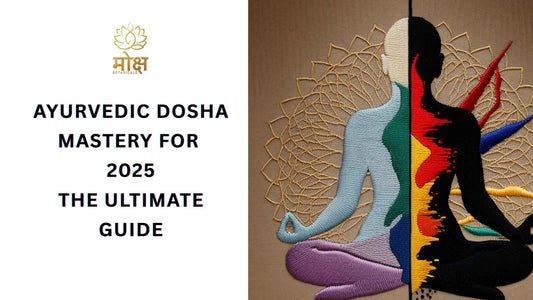
Ayurvedic Dosha Mastery for 2025: The Ultimate Guide
शेयर करना
In the age of Gen-Z Ayurveda, mastering the art of Vata, Pitta, and Kapha is more than an ancient philosophy—it is a high-impact wellness strategy for modern life. This guide unpacks dosha science, weaving trending topics and evidence-based practices with Moksha Botanicals’ targeted formulations into a single, authoritative resource.
What's Inside This Guide:
- The Rise of Gen-Z Ayurveda
- Dosha Fundamentals: Elements & Functions
- Deep-Dive: Vata—The Wind Dosha
- Deep-Dive: Pitta—The Fire Dosha
- Deep-Dive: Kapha—The Earth-Water Dosha
- Dual & Tri-Dosha Dynamics
- Circadian Rhythm & Daily Hacks (Dinacharya)
- Intermittent Fasting by Dosha
- Skin-Care Protocols by Dosha
- Gut & Hormonal Health (PCOS Focus)
- Moksha Botanicals Product Matrix
- Frequently Asked Questions (FAQs)
- Your Action Plan & Free Downloads
The Rise of Gen-Z Ayurveda
Millennial and Gen-Z consumers now constitute a significant part of the global Ayurveda clientele, driven by burnout, eco-anxiety, and a pivot toward plant-based healing. Social media trends like “#genzayurveda,” “dosha quiz,” and “natural hormone balance” highlight a growing demand for authentic, personalized wellness solutions.
Dosha Fundamentals: Elements & Functions
| Dosha | Dominant Elements | Core Qualities | Primary Roles | Imbalance Manifestations |
|---|---|---|---|---|
| Vata | Ether + Air | Light, dry, mobile | Nerve impulses, respiration, elimination | Anxiety, dryness, constipation |
| Pitta | Fire + Water | Hot, sharp, oily | Digestion, metabolism, temperature | Inflammation, ulcers, irritability |
| Kapha | Earth + Water | Heavy, slow, stable | Structure, lubrication, immunity | Weight gain, congestion, lethargy |
Deep-Dive: Vata—Bio-Hacking the Wind Dosha
Hallmark Traits
Vata governs motion, creativity, and nervous system signaling. When in balance, it fosters creativity and flexibility. When out of balance, it causes anxiety, insomnia, and dryness.
Core Practices for Balancing Vata
- Diet: Focus on warm, cooked, grounding foods. Think oats porridge with ghee, avocado toast, root vegetable stews, and spiced almond milk.
- Lifestyle: Establish a consistent routine. Practice warm oil massage (Abhyanga), gentle yin yoga, and ensure a minimum of 7 hours of sleep.
- Intermittent Fasting: A gentle 12-hour overnight fast is best to avoid depleting Vata.
Moksha Botanicals Protocol for Vata
For calming Vata-induced anxiousness and promoting groundedness, Arjav is our primary recommendation. It's a blend of Malkangni and Brahmi, designed to soothe the nervous system.
Discover Arjav for Vata BalanceDeep-Dive: Pitta—Harnessing the Digital-Age Fire
Hallmark Traits
Pitta rules enzymatic activity, metabolism, and decisive intellect. A balanced Pitta leads to sharp focus and effective leadership. Imbalance manifests as inflammation, skin rashes, and irritability.
Core Practices for Balancing Pitta
- Diet: Choose cooling, non-spicy foods. Enjoy cucumber salads, coconut water, barley, and fresh, sweet fruits.
- Lifestyle: Avoid overheating. Enjoy moon-lit walks, practice cooling pranayama (breathing exercises), and never skip sunscreen.
- Intermittent Fasting: A 14–16 hour window works well. Break your fast with cooling, hydrating foods.
Moksha Botanicals Protocol for Pitta
NirAmay is formulated to pacify Pitta heat. Its cooling blend of Giloy, Amla, Haldi, and Tusi helps reduce inflammation and supports liver function.
Explore NirAmay for Pitta ReliefDeep-Dive: Kapha—Lighting the Earth-Water Engine
Hallmark Traits
Kapha provides structure, immunity, and emotional steadiness. In balance, it brings strength and compassion. Out of balance, it leads to lethargy, weight gain, and congestion.
Core Practices for Balancing Kapha
- Diet: Opt for light, dry, and warm foods. Steamed vegetables, legumes, and stimulating spices like ginger, black pepper, and cinnamon are excellent.
- Lifestyle: Stay active and seek stimulation. Practice HIIT, dry brushing (Garshana) before showering, and regularly declutter your living spaces.
- Intermittent Fasting: A 16–18 hour fast is highly effective for igniting digestive fire (Agni) and managing weight.
Moksha Botanicals Protocol for Kapha
To counter sluggishness, NirAmay boosts metabolism and invigorates the system with its blend of Giloy, Dalchini, Amla, Tulsi, and many more.
Boost Energy with NiramayDual & Tri-Dosha Dynamics
Many people have a dual-dosha constitution. Balancing requires addressing both energies. Here are our recommended combinations:
| Constitution | Common Triggers | Recommended Product Stack |
|---|---|---|
| Vata-Pitta | Late-night screen time, spicy snacks, high stress | Arjav + NirAmay |
| Vata-Kapha | Long flights, cold weather, heavy desserts | Arjav + MoolPrana |
| Pitta-Kapha | Sedentary work in a warm climate, dairy excess | NirAmay + MoolPrana |
| Tri-Dosha | Irregular routines, seasonal changes | Arjav + NirAmay + MoolPrana (in equal parts) |
Circadian Rhythm & Daily Hacks (Dinacharya)
Aligning your day with nature's rhythm is a cornerstone of Ayurveda. Here's a simple template:
- 05:30 AM (Vata time): Wake, tongue scrape, drink warm lemon water.
- 06:30 AM (Kapha time): Cardio or yoga, followed by a dry brush massage.
- 10:00 AM (Pitta time): Your peak productivity window for deep work.
- 12:30 PM (Pitta peak): Eat your largest meal of the day.
- 06:00 PM (Kapha time): Enjoy a light dinner and a gentle walk.
- 09:30 PM (Transition): Turn off screens, practice sleep hygiene, and prepare for rest.
Intermittent Fasting by Dosha
| Dosha | Ideal Fast : Feed Window | Key Benefits |
|---|---|---|
| Vata | 12:12 (e.g., 7 PM to 7 AM) | Gently rests the digestive tract |
| Pitta | 14:10 (e.g., 6 PM to 8 AM) | Reduces inflammation and cools the system |
| Kapha | 16:8 or 18:6 | Enhances metabolism and weight management |
Skin-Care Protocols by Dosha
| Dosha | Skin Type | Key Botanical Actives | Moksha Tip |
|---|---|---|---|
| Vata | Dry, thin, fine pores | Sesame, Almond, Saffron Oils | Use a nourishing, oil-based serum daily. |
| Pitta | Sensitive, prone to redness/acne | Aloe, Rose, Manjistha, Sandalwood | Apply a cooling gel or mask after sun exposure. |
| Kapha | Oily, large pores, dull | Neem, Turmeric, Tulsi, Clay | Use a clarifying clay mask 2-3 times per week. |
Gut & Hormonal Health (PCOS Focus)
Kapha-Pitta dysregulation is strongly linked to the metabolic challenges of PCOS. An integrated protocol of a Kapha-reducing diet, 16:8 intermittent fasting, and Moksha’s MoolVeer (Shilajit Resin) can significantly promote insulin sensitivity and support healthy ovarian function.
Learn About MoolVeer for PCOS SupportMoksha Botanicals Product Matrix
| Product | Dosha Target | Primary Benefit | Perfect For... |
|---|---|---|---|
| Arjav | Vata | Calming adaptogens | Stress, anxiety, and sleeplessness |
| NirAmay | Pitta | Triple-cooling herbs | Heat, inflammation, and skin irritation |
| MoolPrana | Kapha | Thermogenic blend | Sluggish metabolism and low energy |
| MoolVeer | Kapha-Pitta | Shilajit Resin | Hormonal balance and PCOS support |
| Veeratva | Kapha | Mineral-rich Shilajit | Joint lubrication and physical stamina |
Frequently Asked Questions (FAQs)
Can I be two doshas at once?
Absolutely. Most people have a dual-dosha constitution (e.g., Vata-Pitta or Pitta-Kapha). The key is to identify which dosha is currently more aggravated and balance it, while gently supporting the other. Our dual-dosha product stacks are designed for this purpose.
Is intermittent fasting safe for all women, especially those with hormonal issues?
When done correctly according to your dosha, yes. For instance, a Pitta type with hormonal issues should stick to a gentler 14-hour fast and consume cooling, nourishing foods. A Vata type should be even more cautious with a 12-hour fast. Always listen to your body and consult a professional if needed.
Which Moksha product is best for travel-induced jet lag?
Jet lag is a classic Vata imbalance caused by excess movement and disruption of routine. Arjav is the perfect travel companion to calm your nervous system. Pair it with staying hydrated and performing a simple sesame oil massage on your feet before bed.
Your Action Plan & Next Steps
Ready to discover your unique constitution and begin your journey to balance?
Start with our quick quiz and unlock personalized recommendations.
"Balance is not something you find, it's something you create."Take the Dosha Quiz & Get 10% Off! Download Your Free 7-Day Dosha Meal Planner




/smstreet/media/media_files/2024/12/17/HCvMLGuFSjQq7XXJ8lxT.jpg)
